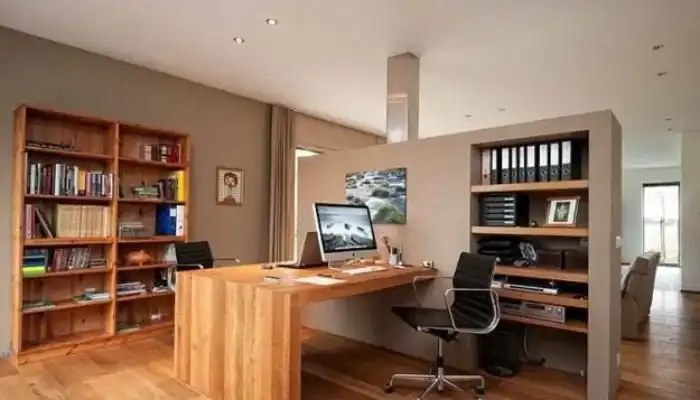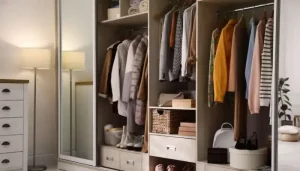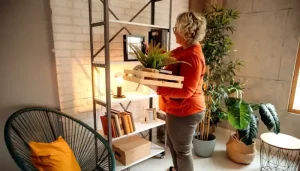A well-designed home office can be the key to productivity and well-being. Free from the distractions of a traditional workplace, it offers the flexibility to create a space that perfectly suits your needs.
However, transforming a spare room into a functional and focused haven requires some planning. This guide will walk you through the essential steps to designing a home office that fosters productivity, comfort, and a healthy work-life balance.

The Foundation for a Functional Home Office
Before diving into furniture selection and paint colors, take a step back and assess your needs. Here’s how:
- Work Requirements:
Consider your daily tasks. Do you need a large workspace for spreading out paperwork? Frequent video calls necessitate good lighting and a clear background. Identify your core work activities to determine the space and equipment required.
- Ergonomics Matter:
Ergonomics is the science of designing workplaces to minimize discomfort and prevent injuries. Invest in an ergonomic chair that provides proper back and neck support, and a desk that allows you to maintain good posture while working.
- Space and Resources:
Measure your available space and consider the existing layout. Can you dedicate a whole room, or will you carve out a corner of a living area? Be realistic about your resources and budget when planning furniture and equipment purchases.
Designing a Productive Layout: Optimizing Your Home Office Space
Once you understand your needs, consider the layout of your home office:
Location, Location, Location:
Choose a quiet area with minimal foot traffic and distractions. Ideally, the space should have a door to allow for visual and auditory privacy. If a dedicated room isn’t possible, consider using a room divider to create a defined workspace.
Harnessing Natural Light:
Natural light is essential for a healthy and productive work environment. Position your desk near a window to maximize natural light exposure. Incorporate adjustable lighting to combat glare and provide adequate illumination during darker hours. Proper ventilation is also crucial, so ensure good airflow.
Arranging for Efficiency:
Furniture arrangement plays a key role in creating a productive flow. Place your desk facing a wall or window to minimize distractions. Position frequently used items within easy reach, and keep walkways clear to avoid clutter build-up.
Essential Furniture and Equipment: Equipping Your Home Office for Success
Now it’s time to furnish your home office for comfort and efficiency:
- The Ergonomic Duo: Desk and Chair: Investing in a high-quality ergonomic chair with adjustable features is crucial for maintaining good posture and preventing back pain. Choose a desk of an appropriate height for your chair, with enough surface area to accommodate your computer monitor, keyboard, and essential work materials.
- Conquering the Clutter: Storage Solutions: Effective storage solutions are essential for a clutter-free and organized home office. Consider filing cabinets, shelves, or desk organizers to keep documents, office supplies, and equipment neatly stored. Vertical storage options like wall shelves maximize space utilization.
- Tech Essentials: Your computer is the heart of your home office. Ensure it meets your processing power needs for your specific software and tasks. A reliable printer and scanner may also be essential, depending on your work requirements. Invest in comfortable computer accessories like a wireless keyboard and mouse to promote good posture and reduce strain.
Creating a Distraction-Free Sanctuary
Your home office should be a haven for focused work. Here’s how to minimize distractions:
- Minimize Noise Disruptions: Invest in noise-canceling headphones or earplugs to block out background noise. If possible, choose a location away from noisy household appliances or common areas. Discuss your work schedule with family members or roommates and establish quiet times to minimize interruptions.
- Visual Boundaries: Create visual boundaries to separate your workspace from the rest of your home. This can be achieved with a room divider, strategically placed plants, or a simple curtain.
- Routine is Key: Establish a daily routine for your workday. Set work hours and stick to them as much as possible. Communicate your work schedule with others at home to manage expectations and minimize interruptions. Take regular breaks to avoid burnout and maintain focus.
By following these steps, you can create a functional and focused home office that fosters productivity, comfort, and well-being. Remember, your home office is an extension of your work style. Personalize it with elements that spark joy and inspire you. Here are some ideas:
- Inspiring Artwork and Décor: Hang artwork, motivational quotes, or photographs that reflect your personality and interests. Surround yourself with visuals that inspire creativity and keep you motivated.
- A Touch of Nature: Indoor plants not only add a touch of life to your workspace but can also improve air quality and reduce stress. Choose low-maintenance plants that thrive in indirect sunlight.
- Comfort Touches: A cozy throw blanket or a comfortable chair pad can make a big difference in comfort, especially during long workdays.
- Bring in the Color: While a neutral color palette promotes a sense of calm, consider incorporating pops of color through accent pieces like a lamp, a chair, or a rug. Choose colors that uplift your mood and inspire creativity.
Optimizing Your Home Office for Long-Term Success
A well-designed home office is an investment in your productivity and well-being. Here are some additional tips for long-term success:
- Embrace Natural Light: Maximize natural light exposure whenever possible. Open blinds and curtains during the day, and consider installing skylights if feasible. Natural light not only improves mood but also regulates sleep patterns.
- Declutter Regularly: Schedule regular decluttering sessions to prevent clutter build-up. A cluttered workspace can be visually overwhelming and hinder focus.
- Invest in Quality Equipment: Investing in high-quality office equipment can significantly improve your workday experience. A comfortable chair, a reliable computer, and a good quality monitor can make a world of difference in terms of comfort and productivity.
- Take Breaks and Move Around: Sitting for extended periods can be detrimental to your health. Set reminders to take regular breaks, get up and move around, or perform some simple stretches.
Conclusion
Crafting a functional and focused home office is an investment in your professional success and overall well-being. By following these steps and incorporating elements that reflect your personality and work style, you can create a personalized workspace that fosters productivity, comfort, and a healthy work-life balance. Remember, your home office is your sanctuary; design it to be a space where you can thrive.


